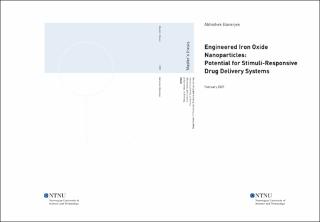| dc.description.abstract | Nanomaterials have gained a lot of attention in the past few decades as potential candidates for biomedical applications. Currently, research with different nanomaterials is being carried out for enhancing existing in-vivo imaging techniques, wound dressing, tissue engineering, heat induced treatment and targeted drug delivery, where polymeric and inorganic nanoparticles have shown wide potential. These materials have not only been engineered individually for specific applications, but also combined for producing hybrid systems in order to address multiple areas at once.(1) Two materials that have specifically caught attention are hydrogels and iron oxide nanoparticles (IONPs).
The high-water affinity of hydrogels makes them flexible and soft emulating properties of living tissues. They also exhibit good biocompatibility and biodegradability, thus proving to be interesting materials for usage in field of biomedicine.(2) These materials can also be engineered to incorporate multiple stimuli-responsive properties that are sensitive to light, heat, pH, radiation, and electrical signals. Thus, multi-responsive hydrogels have previously been utilized and have shown potential as targeted drug delivery devices, with low toxicity and undesired side effects as compared to conventional techniques. Parallelly, IONPs have also gained wide importance in therapeutics and theranostics over the past two decades due to the possibility of controllable synthesis, thereby producing extremely small (< 20 nm) particles, having different morphology, high monodispersity, and unique superparamagnetic properties.(3, 4) By utilizing their superparamagnetic characteristic, heat can be generated from IONPs on exposure to alternating magnetic fields (AMF), at radio frequency region.(5) This has opened up a field of treatment, called hyperthermia, whereby the heat produced from IONPs can be used for cell apoptosis (killing).(6) However, unwanted, and uncontrolled production of heat can also affect healthy cells and tissues leading to side effects. Utilizing hydrogels to surface engineer IONPs, for producing hybrid structures could be the next potential solution for mitigating the above stated problem. Henceforth, heat produced from IONPs could be localized or controlled with hydrogel coating and could be utilized to trigger release of bioactive agents from these hybrid structures, thus, making treatments more target specific with less side effects. The stimuli-responsive contribution from hydrogels could also be engineered, making these hybrid systems even more efficient.
In this work, controlled and reproducible synthesis of monodisperse IONPs (16 ± 2 nm) (in organic media) was done using thermal decomposition method. The synthesized IONPs were phase transferred from organic to aqueous media using sodium citrate, in order to make the IONPs dispersible in water, which forms the steppingstone for biomedical application. Sodium citrate electrostatically stabilized the IONPs in water, which was seen from negative zeta potential values, measured using Dynamic Light Scattering (DLS). The stability of these particles was also tested at elevated temperatures (45 ºC and 60 ºC), prolonged storage periods (2 months) and different pH conditions ranging from acidic to alkaline (pH 3 to 8) before being used further. Heat generation of these particles were also studied at optimized AMF condition (587 kHz, 12 mT). These particles showed significantly low specific absorption rates (SAR) (1.76 W/g) as compared to conventional magnetite NPs, which was also in accordance with the concept of achieving controlled heating.
Parallelly, a hydrogel, (poly- (N-isopropyl acrylamide-acrylic acid)) was tailored with thermal and pH responsive properties. These systems showed collapse efficiencies ~ 97 % at 45 ºC and also reduction in hydrodynamic size (~ 63 nm) was seen at acidic pH=3.5 condition. Two systems; phase transferred IONPs and NGs, were characterized individually and used in conjunction to synthesize hybrid NGs with potential of being utilized as drug delivery devices.
Hybrid NGs were synthesized using three different techniques, with the idea of producing hybrid systems with different physico-chemical properties which could open up new opportunities as novel drug-delivery systems. With difference in synthesis techniques, the hybrid systems showed different thermo-responsive properties which was analyzed by studying the collapses of these systems at elevated temperatures (45 ºC). The systems were superparamagnetic and also pH responsive, which showed retention of magnetic properties from IONPs and pH responsive properties from NGs polymeric structures when combined together. Henceforth, successful synthesis of hybrid systems with thermal, pH and magneto-responsive properties were shown in this study.
The hybrid systems were then loaded with a model protein, Cytochrome C (cyt C), and the effect of thermal and pH responsive properties of hybrid systems on release of cyt C was studied under condition – 40 ºC and pH (3.5). The release of cyt C was tracked using UV-Vis spectroscopy (UV-vis) for ~ 20 hours and the release profiles obtained were fitted with common mathematical models and analyzed. Hybrid NGs synthesized via in situ technique showed slowest release rates for the first two hours (0.08 hour-1) as compared to other hybrid systems, showing potential as slower or sustained release systems.
Lastly, to understand how magneto-responsive properties of these hybrid systems effected release of cyt C, release studies were done under AMF condition for 10 hours. A major challenge faced during this study, was unwanted production of background heat from water due to formation of eddy currents. Henceforth, optimizations were tried, to mitigate the background heat signal. Real-time monitoring of the temperature within the systems were performed for the entire duration of the study. No noticeable changes in release profile of cyt C was seen on exposure to AMF condition. This was because the release signal of cyt C due to controlled heat produced from hybrid systems were masked by background heating effects. | |
